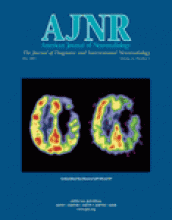Abstract
BACKGROUND AND PURPOSE: Diffusion tensor imaging measures the proton diffusivity and preferential orientation of the diffusion tensor. X-linked adrenoleukodystrophy is a demyelinating disease for which therapy depends on the onset and extension of demyelination. We investigated the ability of diffusion tensor imaging to detect changes in the demyelinated lesions and in the normal appearing white matter.
METHODS: Diffusion tensor imaging of three related boys with X-linked adrenoleukodystrophy and seven age-matched control participants was performed. Isotropic diffusion (D′) and fractional anisotropy (FA) values were determined in 18 regions of interest in the white matter of both hemispheres.
RESULTS: In all the demyelinated white matter areas, a pattern with increased D′ and loss of FA was found. For example, mean D′ was 1.772 × 10−3mm2/s in patient 2 with blindness and extensive demyelination of the occipital white matter and was 0.693 × 10−3mm2/s in control participants (P = .01). In the same region, mean FA was 0.103 (0.464 in control participants, P < .0001). Significant alterations of D′ and FA were also observed in normal appearing white matter. For example, mean D′ was 0.802 × 10−3mm2/s in the parietal white matter of patient 1 with no visible alterations on T2-weighted images (0.715 × 10−3 mm2/s in control patients, P = .03), whereas mean FA was 0.320 (0.400 in control participants, P = .003).
CONCLUSION: Elevated D′ and loss of FA revealed by diffusion tensor imaging are consistent with severe demyelination in patients with X-linked adrenoleukodystrophy. Significant alterations of D′ and FA in normal appearing white matter may indicate early demyelination in areas that are not yet visibly altered on conventional MR images. Further evaluation in a larger series of patients and long-term study are needed.
- Copyright © American Society of Neuroradiology












